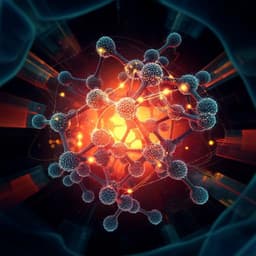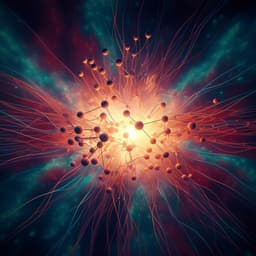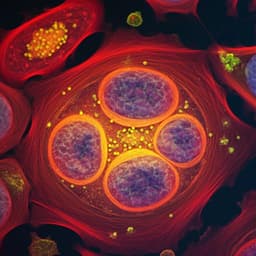Introduction
This research investigates the impact of energy transfer between fluorophores on photoswitching kinetics in super-resolution microscopy. The study focuses on understanding how the proximity of fluorophores, specifically at distances less than 10 nanometers, affects the efficiency and speed of the photoswitching process crucial for techniques like direct stochastic optical reconstruction microscopy (dSTORM) and points accumulation for imaging in nanoscale topography (PAINT). The importance lies in improving the accuracy and resolution of super-resolution microscopy, enabling more detailed visualization of biological structures and processes. Current limitations in super-resolution imaging are often linked to the photoswitching characteristics of fluorophores, including their blinking behavior and the potential for energy transfer interactions to affect the localization precision. Addressing these limitations is crucial for advancing our understanding of biological systems at the nanoscale.
Literature Review
The literature review likely covered existing super-resolution microscopy techniques (dSTORM and DNA-PAINT), the principles of photoswitching, and previous studies investigating energy transfer between fluorophores. It would have explored the impact of energy transfer on fluorescence properties and how these effects translate into the observed images. The researchers likely reviewed studies using DNA origami as a precise nanoscale platform for investigating controlled interfluorophore distances, including work on self-assembly techniques and methods for attaching fluorophores to DNA nanostructures. Relevant publications may include those by Douglas et al. on DNA origami self-assembly and others detailing the use of genetically encoded unnatural amino acids (ncAA) for labeling proteins for super-resolution microscopy.
Methodology
The study employed a combination of experimental and computational techniques. DNA origami structures were designed and synthesized with varying numbers (one to four) and precisely controlled interfluorophore distances (18, 9, 6, and 3 nm) of Cy5 dyes. Two super-resolution techniques, dSTORM and DNA-PAINT, were used to image these structures. The experiments were performed using specific buffers (with MgCl2, EDTA, and Tween 20) optimized for photoswitching. Image analysis was done using rapidSTORM and ThunderSTORM software. The localization precision was calculated according to established methods. Photoswitching fingerprint analysis involved tracking fluorescent spots across image stacks to determine on and off-times, photon counts per frame, and the number of on-time events. Fluorescence lifetime measurements were performed using a time-resolved confocal fluorescence microscope (MicroTime200), with single-molecule trajectories and photon antibunching experiments conducted. Photon antibunching data were analyzed to assess the number of independent emitters. Time-correlated single-photon counting (TCSPC) was used for fluorescence lifetime analysis, with data analyzed using FluoFit software. Click chemistry labeling was employed in some experiments to enhance detection of GluK2 protein variants with introduced unnatural amino acids. The overall methodology involved careful control of experimental conditions and rigorous data analysis to ensure accuracy and reproducibility. All experiments were performed at least three times.
Key Findings
The key findings revolved around the impact of interfluorophore distances on photoswitching kinetics. dSTORM and DNA-PAINT imaging demonstrated that at interfluorophore distances less than 10 nm, the photoswitching behavior changed. Specifically, the time required to acquire 80% of localizations (80%-time) significantly decreased at shorter distances (3 and 6 nm). Photon antibunching experiments demonstrated that, even with multiple fluorophores present, the on-state is predominantly dominated by the emission of a single fluorophore due to energy transfer processes, like homo energy transfer and singlet-singlet annihilation. This suggests that energy transfer between closely spaced fluorophores accelerates the photoswitching process, leading to faster data acquisition. The analysis of fluorescence lifetime trajectories further supported the observation that shorter interfluorophore distances result in altered photoswitching kinetics. The experiments with GluK2 protein constructs and click chemistry labeling provided independent validation of the findings and expanded understanding on the applicability of this discovery for super-resolution microscopy of biomolecules.
Discussion
The findings directly address the research question of how energy transfer between fluorophores impacts photoswitching. The observed acceleration of photoswitching at close distances has significant implications for super-resolution microscopy. It indicates that the energy transfer mechanisms are not necessarily detrimental to image quality but can actually enhance data acquisition speed. This suggests that careful control of fluorophore proximity can improve the efficiency of super-resolution imaging. The results show that for distances below 10nm, the energy transfer events, while leading to only single fluorophore emission in the on-state, result in faster repopulation of the on-state leading to faster data acquisition. The combination of dSTORM, DNA-PAINT, fluorescence lifetime analysis and photon antibunching experiments provides robust evidence supporting this conclusion. Future work could explore optimizing fluorophore placement and density to further improve super-resolution imaging performance and expand the scope to different types of fluorophores and biological systems. This improved understanding can lead to advancements in the design and optimization of super-resolution imaging strategies.
Conclusion
This research demonstrates that energy transfer between fluorophores at sub-10 nm distances accelerates photoswitching kinetics in super-resolution microscopy. This finding has significant implications for optimizing the design and performance of future super-resolution imaging techniques. Further investigation is warranted to explore the broader implications of this discovery across various fluorophores and biological contexts. Optimizing fluorophore placement strategies based on this understanding could substantially enhance image acquisition efficiency and resolution.
Limitations
The study primarily used DNA origami as a model system, which may not fully reflect the complexity of biological samples. The precise control over fluorophore distances in DNA origami may not be entirely representative of the spatial arrangements of fluorophores in biological macromolecules. Furthermore, the effects of energy transfer might vary depending on the specific fluorophores used and their surrounding environment. The study's focus on a limited range of interfluorophore distances could also be considered a limitation, as the relationship between energy transfer and photoswitching kinetics might be different at other distances.
Related Publications
Explore these studies to deepen your understanding of the subject.






